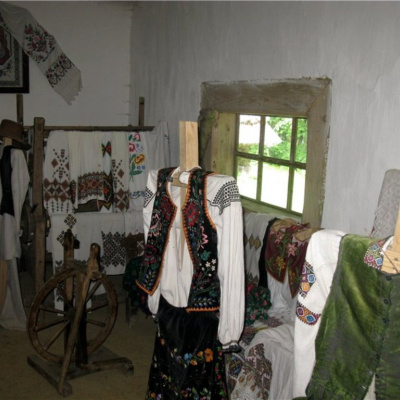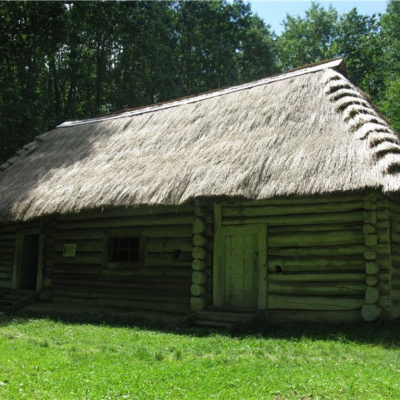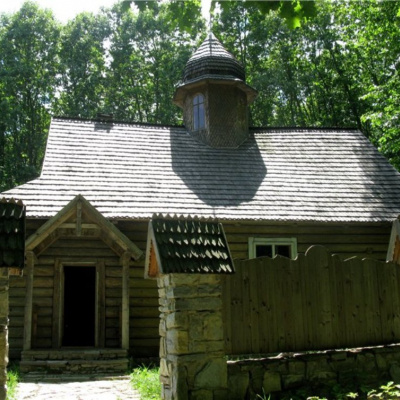Museum of Folk Architecture and Life of Prykarpattia in Krylos
Next to the road connecting Lviv and Ivano-Frankivsk, near the village of Krylos in Halychyna district, is the Museum of Folk Architecture of Prykarpattia. Its new name is the Museum of Ethnography. It is a small, well-kept and beautiful open-air museum. It is especially cozy here in hot weather, because the Museum of Folk Architecture of Prykarpattia was created in the forest. You can go inside all the museum buildings, and there is plenty to see. Children especially like such places, and adults will find a lot of new things in the museum. What are berbenits or shelters? How did they make oil in ancient times? Where is a good place to build a new house and where is a bad place? The guides will tell you about all this and much more. The Museum of Ethnography is a part of the Ancient Halych National Reserve.
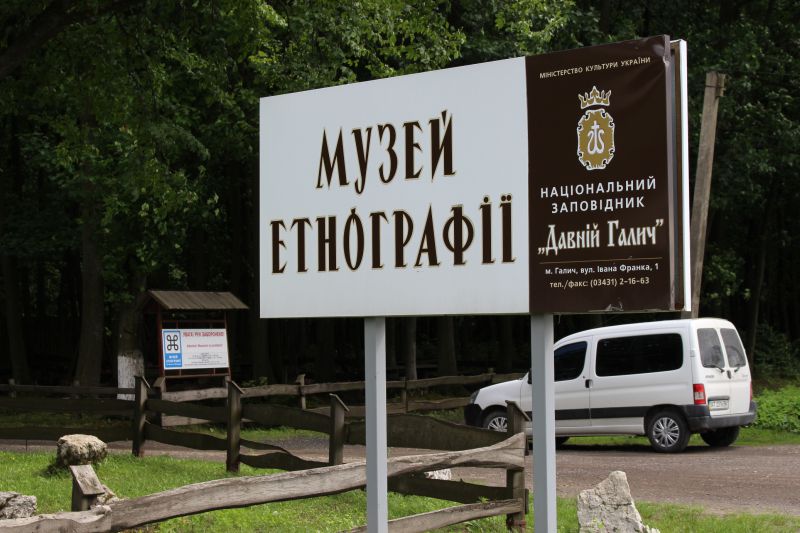
It is located on the territory of the ancient settlement, on the first line of the defensive ramparts, opposite the Prokaliyiv Sad tract. The museum was founded in 1981. This island of folk architecture introduces visitors to the architecture and life of the inhabitants of Prykarpattia in the late seventeenth and early twentieth centuries. The buildings on the museum's territory testify to the originality of Ukrainian folk architecture and, at the same time, to its inextricable links with the traditions of the building culture of the Slavic peoples. On an area of 6.8 hectares, the construction of "micro-villages" of four ethnographic districts of Prykarpattia: Pokuttya, Hutsul, Boykivshchyna, and Opillya is currently being completed. Each of these zones is skillfully planned in the microrelief of the area, decorated with small architectural forms. The interiors of the monuments contain a lot of ethnographic relics - objects of life and everyday life of our ancestors. However, the small exhibition area has led to a number of differences between this museum and similar ones.
In particular, many architectural exhibits are presented not as manors - residential and industrial ensembles of rural buildings of the past - but as single, typical examples of residential, commercial and industrial buildings. Currently, the museum has 11 architectural monuments representing different types of residential and commercial construction. The interiors of the monuments contain many ethnographic relics - objects of life and everyday life of our ancestors: a large collection of dishes (plates, cups, jugs, pots), folk fabrics, traditional clothes for the region, numerous samples of embroidery (women's and men's shirts, hoops, sheets).
The Pokuttya region is represented by a traditional Pokuttya manor house of the late seventeenth and early twentieth centuries (transported from the village of Torgovytsia, Horodenka district), which includes a house, a cattle stable, a fence, a crane well, and a fence. In the Pokutska hut there is a collection of dishes (plates, cups, jugs, pots). The walls inside and outside are covered with clay and whitewashed. The four-pitched roof is interesting, covered with rye straw sheaves. The house is half smoked.
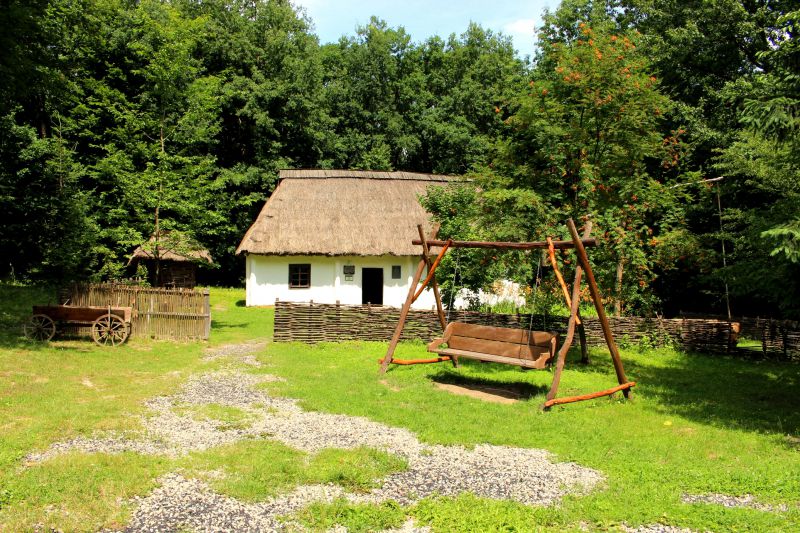
Pokuttya is also represented by an oil mill, a typical household building in all regions of Ukraine, which, however, has its own peculiarities everywhere. The oil mill was built in the late 19th century and transported from the village of Oleshni in Tlumach district. It introduces visitors to the process of oil production.
Two huts from the village of Usteriky in Verkhovyna district of the late nineteenth century, as well as a typical Hutsul house of the 1940s, which was moved from the village of Vorokhty in Yaremche district, were moved to the museum from theethnographic and one of the most original Hutsul regions. This is a three-chambered dwelling - a hut-hut-barn. In the Vorokhta house there is a working loom that used to make carpets and Hutsul clothes.
The peculiarity of the Hutsul region is that the Hutsul homesteads are scattered at a considerable distance from each other in the mountains and valleys. This isolation and the constant need to defend themselves led to the tradition of surrounding the house with a blank fence. This is how the Hutsul hut-hrazhda appeared: a closed building with a house, a barn, and shelters, which were typical for the housing construction of that period. Hrazhdy were a kind of fortresses where people hid from wild animals, uninvited guests, or even from an avalanche. It makes it possible to reveal a number of traditional methods of housing construction in the Hutsul region. The main building of the yard is a hut, which consists of two rooms separated by a hallway. The main building material is wood. The roof of the building is covered with shingles.
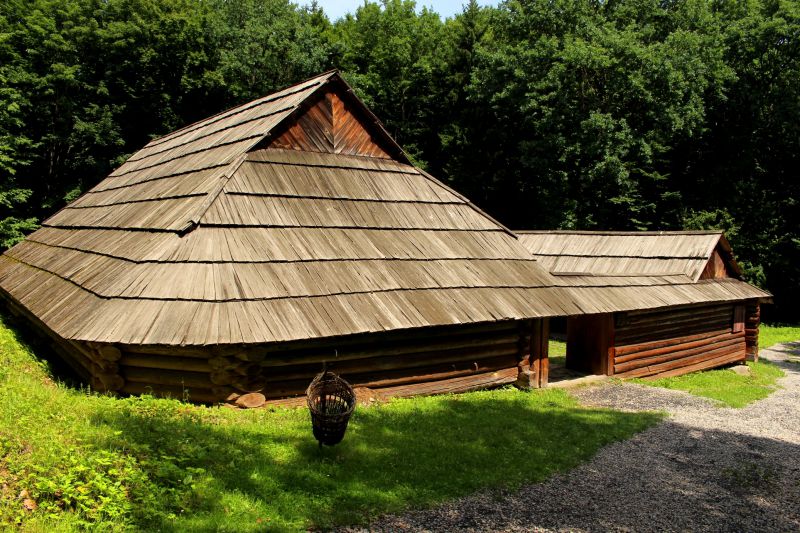
Boikivshchyna is represented by a traditional hut from 1878 (as evidenced by the date on the roof), transported from the village of Polianytsi in Dolyna district. This priest's house is a three-chambered dusty hut built in 1787. It has kudelas and spinning wheels on display. In one of the rooms, there is an exposition of a one-class school "dyakivka". Here you can also see the largest collection of folk fabrics, embroidery, and clothing. There is a Boyko barn not far from the house.
Theethnographic area of Opillia is represented by a manor house with a mid-nineteenth-century weaver's house and a late nineteenth-century barn, both transported from the village of Viktoriv , Halych district. The house of a wealthy peasant. There is a collection of embroidery from the villages of Pohatyn and Halych districts. These are women's and men's shirts, hoops, sheets, pashvys, as well as folk clothes - men's and women's, everyday and festive. Vehicles and tools are on display in the outbuildings, the barn.
Perhapsthe most interesting exhibits of the ethnoharphic museum in Krylos are the early twentieth-centurywooden church of All Saints from the village of Poplavnyky, Halychyna district(it has a typical and at the same time original architecture close to the house construction that was once common throughout Galicia) and the production building - a forge from the village of Tenetnyky, Halychyna district. There is also a very large collection of Opillya embroidery - women's and men's shirts, hoops, sheets, pashvys, and folk clothes.
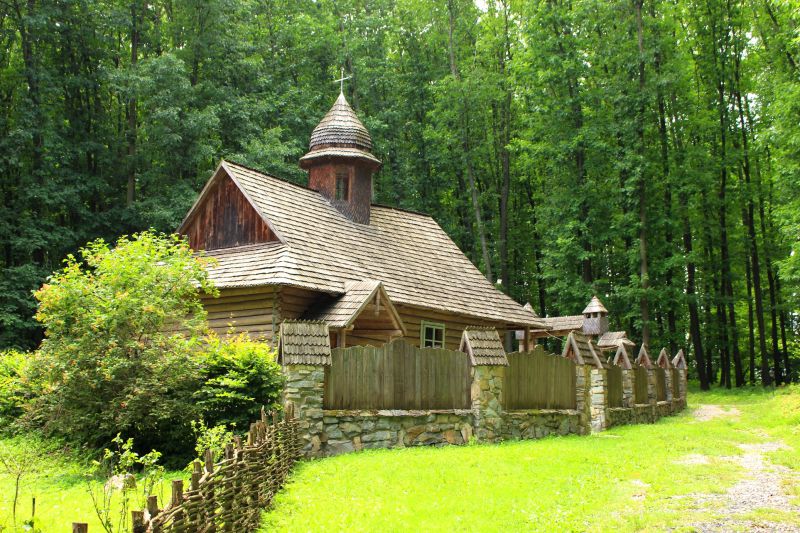
The houses in the Museum of Folk Architecture and Rural Life of Prykarpattia are all original, presented as examples of Prykarpattia housing. They are installed in the museum's square in the appropriate thematic context. The only exceptions are some exhibits - small architectural forms that are very quickly destroyed in villages, because they were usually built of lesser quality materials. The exhibits for the interiors of houses are also collected in accordance with the specifics of the regions.
In the near future, the museum plans to build a water mill, a Hutsul church, a fullushnya, an inn, an entrance tower, etc.
The Museum of Architecture and Rural Life of Prykarpattia (Museum of Ethnography) can be reached by the H09 highway. It is located on the road between Halych and Krylos. The landmark is the Swordand Ralo monument .
Museum opening hours: 9:00-17:00 daily.
Entrance fees: adult- 10 UAH, children - 5 UAH.
Guidedtours: 200 UAH for adults, 100 UAH for children.
Accommodation around Museum of Folk Architecture and Life of Prykarpattia in Krylos:
Які маршрути проходять повз Museum of Folk Architecture and Life of Prykarpattia in Krylos?
Пропонуємо пройти такі туристичні (пішохідні) маршрути через/біля Museum of Folk Architecture and Life of Prykarpattia in Krylos: с. Пасічна, через с. Манява, Манявський вдсп., г. Велика Сивуля до с. Бистриця, с. Манява - пол. Монастирецька, с. Манява - вдсп. Манявський, с. Гута - с. Пасічна, с. Пасічна, через г. Синячка до м. Яремче, с. Дора, через г. Синячка, пер. Пересліп, пол. Туршугувата, хр. Явірник до м. Яремче
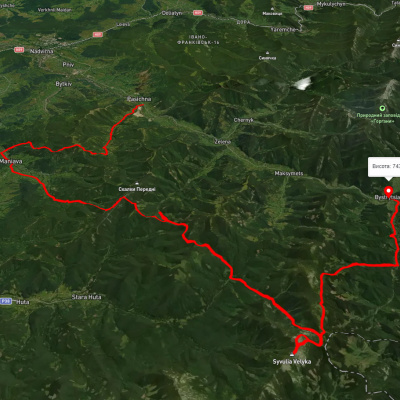
с. Пасічна, через с. Манява, Манявський вдсп., г. Велика Сивуля до с. Бистриця
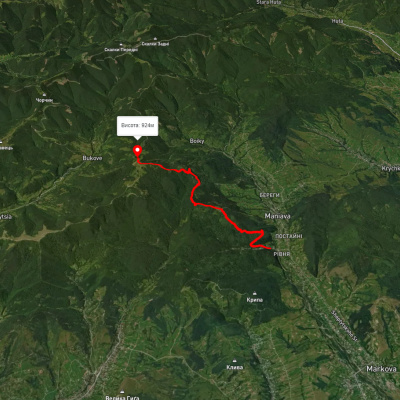
с. Манява - пол. Монастирецька
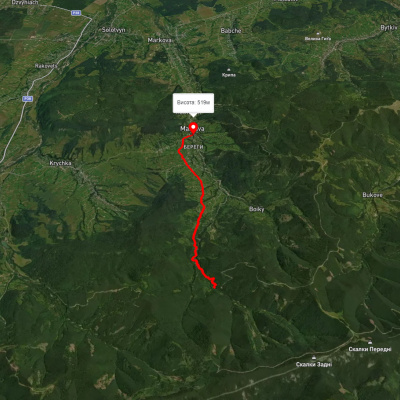
с. Манява - вдсп. Манявський
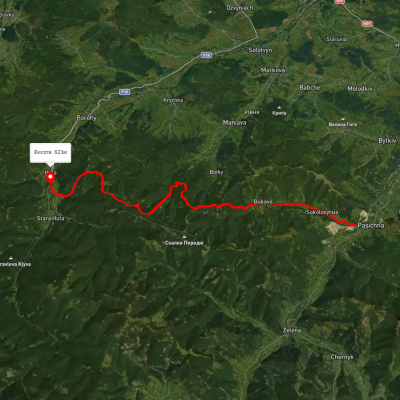
с. Гута - с. Пасічна

